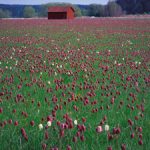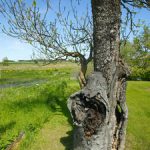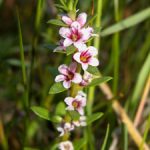The entire distance from the harbour to Linnaeus’s Hammarby is 16 km, which can be divided up thus:
Uppsala harbour to Vindbron 2,6 km.
Vindbron to Kuggebro 2,2 km.
Kuggebro to Linnaeus’s Sävja 4,2 km.
Danmark Church to Linnaeus’s Hammarby 2,7 km.
Linnaeus’s Sävja to Danmark Church 4,3 km.
Read more about the trail in the folder.
For information about buses along the trail, see Upplands Lokaltrafik.
Interesting places along the Danmark trail
During the 1740s, Carl Linnaeus introduced highly popular excursions into his teaching, which he entitled Herbationes Upsalienses. Herbatio Danensis commenced at Kungsängtull, leading across Kungsängen with its newly discovered King’s Lily and on to the Danmark Church. After 1758, the excursion was extended to Linnaeus’s estates at Sävja and Hammarby.
In 1742, Linnaeus’s friend, Sten Carl Bielke travelled across Kungsängen. There, he found Fritillaria meleagris, the plant known today as King’s Lily. Bielke reported his find to Linnaeus, who immediately understood that it had spread there from Uppsala Botanical Garden. Thousands of King’s Lilies blossom at Kungsängen in the middle of May.
Here at Nåntuna grove, Linnaeus stopped to show grove plants and allow the students to gather insects. In those days, the grove was grazed and much more open. Since 1953, part of Nåntuna grove has been projected as a nature reserve. There are also many Iron Age graves in the area.
Most people have heard of Linnaeus’s Hammarby. A less well-known fact is that Linnaeus also owned an agricultural property in Sävja. Linnaeus purchased Sävja on 14 November 1758, the same year he purchased Hammarby. At Sävja, Linnaeus built two rooms for himself where he could be alone. Here, unlike Hammarby, he did not have to receive students and foreign guests. During Herbatio Danensis, Linnaeus would stop here with his students for breakfast and a brief rest with the farmer who rented the estate.
According to local tradition, Linnaeus planted two ashes at Falebro, one on each side of the southern bridge abutment. This was important for travellers to find their way to the bridge in the dark or in snowstorms on the plane. Today, the only remaining ash is the one which stood west of the old road.
Danmark Church was Linnaeus’s Parish church. His dog, Pompe, would accompany Linnaeus to church lie with his master in the Hammarby pew. Linnaeus would leave after an hour, even if the service was not yet over. When Linnaeus himself did not go to church, the dog would come on his own and lay in his master’s pew. Just like his master, Pompe would get weary after an hour. Then he would bark, jump out of the pew and leave.
Hammarby was dedicated as a cultural reserve on 13 May 2007. Linnaeus purchased Hammarby on 8 December 1758. The residential house contains many furnishing details from Linnaeus’s time and in the park, plants put there by Linnaeus still grow. Following a blaze in Uppsala in 1766, Linnaeus decided to move his collections to Hammarby. He had a small museum built on what was then a totally bare rise behind the estate. The building was completed in 1769 and remains there to this day.



